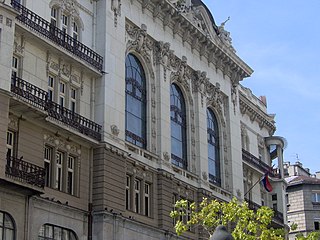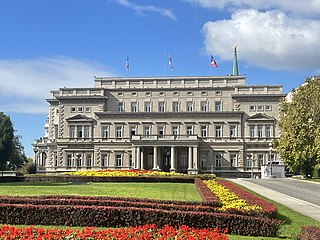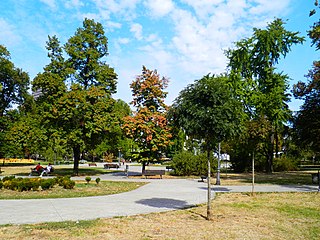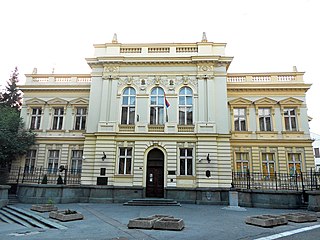Related Research Articles

Knez Mihailova Street is the main pedestrian and shopping zone in Belgrade, and is protected by law as one of the oldest and most valuable landmarks of the city. Named after Mihailo Obrenović III, Prince of Serbia, it features a number of buildings and mansions built during the late 1870s.

Dragiša Brašovan was a Serbian modernist architect, one of the leading architects of the early 20th century in Yugoslavia.

The Serbian Academy of Sciences and Arts is a national academy and the most prominent academic institution in Serbia, founded in 1841 as Society of Serbian Letters.

The St. Mark's Church or the Church of St. Mark is a Serbian Orthodox church located in the Tašmajdan park in Belgrade, Serbia, near the Parliament of Serbia. It was built in the Serbo-Byzantine style by the Krstić brothers, completed in 1940, on the site of a previous church dating to 1835. It is one of the largest churches in the country. There is a small Russian church next to St. Mark's.

Stari Dvor is the city hall of Belgrade, Serbia, housing the office of the Mayor of Belgrade. It was the royal residence of Serbian royal family from 1884 to 1922. The palace is located on the corner of Kralja Milana and Dragoslava Jovanovića streets, opposite Novi Dvor.

The Nikola Pašić Square is one of the central town squares and an urban neighborhoods of Belgrade, the capital of Serbia. The square is named after Nikola Pašić who served as mayor of Belgrade, prime minister of Serbia and prime minister of Yugoslavia. Until 1992 the square was named the Marx and Engels Square.
Cvetkova Pijaca or colloquially Cvetko is an open green market and an urban neighborhood of Belgrade, the capital of Serbia. It is located in Belgrade's municipality of Zvezdara.

Kopitareva Gradina is a square and an urban neighborhood of Belgrade, the capital of Serbia. It is located in Belgrade's municipality of Stari Grad.
Theatre on Đumruk, or Đumrukana, was a theatre in Belgrade, the capital of Serbia. Originally a customs house which was built in 1835 near Belgrade docks in the neighborhood of Savamala, it was adapted into the theater, as a first regular Belgrade theater house, which was active 1841–1842.

Manjež Park is a public park situated in the centre of Belgrade, the capital of Serbia.

The House of the National Assembly, formally the House of the National Assembly of the Republic of Serbia is the seat of the National Assembly of Serbia. The building is located on Nikola Pašić Square in downtown Belgrade, across Novi Dvor and Stari Dvor. Originally intended to be the House of the National Assembly of the Kingdom of Serbia, it was the seat of the Parliament of Yugoslavia and the Parliament of Serbia and Montenegro. Since 2006 it serves as the meeting place of the National Assembly of Serbia.

King Petar I Elementary School is an elementary school in Belgrade, Serbia. The original school was founded in 1718 and is the oldest surviving cultural and educational institution in Serbia, predating the foundations of the Gymnasium of Karlovci (1796), Great School, Matica Srpska (1826) and Society of Serbian Scholarship. It was the first school in Serbia which introduced the teacher notebooks and gym classes and is the location of the first basketball match played in Belgrade.

The Genčić family house in Belgrade, at 51 Krunska Street, was built in 1929 and has housed the Nikola Tesla Museum since 1952.

Nikola Pašić House is located at 21 Francuska Street, in Belgrade, the capital of Serbia. Originally built in 1872 and thoroughly expanded in 1921, it was purchased by the longtime prime minister Nikola Pašić in 1893. It was declared a cultural monument in 1984.

Kneza Miloša Street is a street in downtown Belgrade, Serbia. It was the main city's korzo (promenade) and today is one of the major traffic arteries of the city, location of some of the most important national institutions and a street with the largest number of embassies in Belgrade. It stretches through the territory of three municipalities: Stari Grad, Vračar and Savski Venac. Previously known as Topčider Road, it was later named after prince Miloš Obrenović, the first ruler of modern Serbia.

Faculty of Law Building in Belgrade is at 67 Boulevard of Kralj Aleksandar. A work of architectural – urban value, as well as an angular building, built in accordance with the modernist concept, which significantly expands articulates the wider space, as the first building built solely for the purposes of the Faculty of Law, one of the oldest institutions of higher education in Serbia, also has cultural and historical value. The building of the Faculty of Law was declared a cultural monument.
Zoran Bojovic was a Yugoslav and Serbian architect and engineer who undertook many large scale projects abroad. He is known for his constructions in Nigeria and the Middle East.

Dragutin "Dragiša" S. Milutinović, son of Sima Milutinović Sarajlija, was an engineer, an architect and art historian, a professor at the Grandes écoles, and a member of the Serbian Academy of Sciences and Arts. He collaborated on several research sites in Serbia with architect Mihailo Valtrović.
Andra Stevanović was a Serbian architect and professor at the University of Belgrade. Andra Stevanović and architect Nikola Nestorović collaborated on several major projects in Belgrade that are now considered cultural monuments.
Aleksandar Bugarski (1835–1891) was a Serbian architect who combined the new with the old styles giving the city a distinct feature of its own.
References
- ↑ Conley, Tanja D. (25 February 2020). Urban Architectures in Interwar Yugoslavia. Routledge. ISBN 9780429686450 – via Google Books.
- ↑ Ivić, Pavle (21 November 1995). The History of Serbian Culture. Porthill Publishers. p. 232. ISBN 9781870732314 – via Google Books.
- ↑ Mišković, Nataša (2008). Basare und Boulevards: Belgrad im 19. Jahrhundert (in German). Böhlau Verlag Wien. p. 155. ISBN 978-3-205-77566-9.
- ↑ Kardosch, Velizar M. (21 November 1996). The Principality of Serbia: Postal History and Postage Stamps, 1830-1882. V.M. Kardosch. ISBN 9783952108314 – via Google Books.
- ↑ Serbian Studies. North American Society for Serbian Studies. 1999. pp. 39–40.
- ↑ Ćorović, Ljubica (21 November 2004). Belgrade Tourist Guide. Kreativni centar. p. 98. ISBN 9788677812423 – via Google Books.
- ↑ Popović-Živančević, Mila (21 November 2007). Condition of the Cultural and Natural Heritage in the Balkan Region: Proceedings of the Regional Conference Held in Kladovo, Serbia from 23th to 27th October 2006. National Museum in Belgrade. p. 423. ISBN 9788672690903 – via Google Books.
- ↑ ПРЕГЛЕД СПОМЕНИКА АРХИТЕКТУРЕ У СРБИЈИ XIX ВЕКА heritage.gov.rs